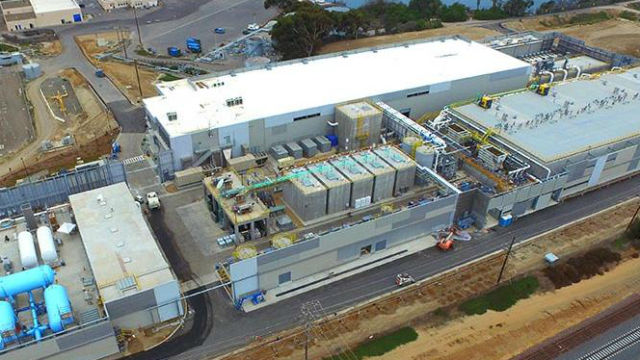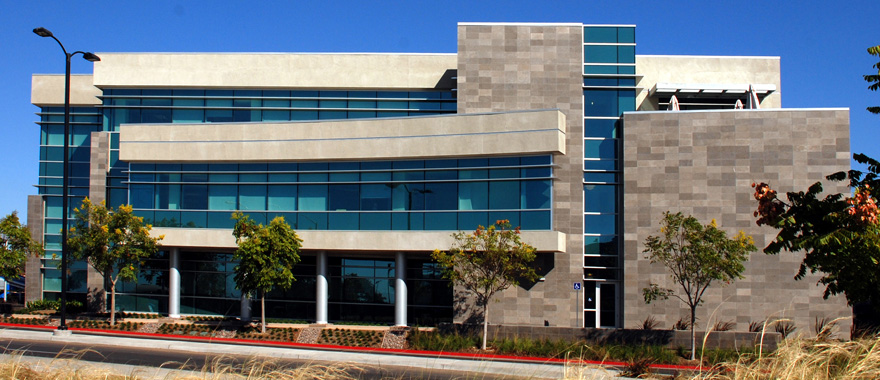Daily Business Report-Dec. 14, 2015
The Carlsbad desalination plant built by Poseidon.
$1 Billion Desalination Plant
To be Dedicated Today in Carlsbad
Times of San Diego
A $1 billion desalination plant — the largest in the Western Hemisphere — will be dedicated in Carlsbad today after lengthy environmental battles and three years of construction.
When water deliveries start soon, the facility at the inlet to the Agua Hedionda Lagoon will provide enough water for 400,000 families, or about 8 percent of the San Diego region’s needs.
The Poseidon Water project also included construction of a 10-mile pipeline that will carry fresh water to San Diego County Water Authority facilities in San Marcos.
Supporters say the plant will give the region a drought-proof source of drinking water that will lower dependence on water imported from the State Water Project and Colorado River.
Approval was bitterly fought by environmental groups, which contended the plant would harm marine life.
“If you look to the examples of where desalination has worked successfully around the world, you will see that those nations worked diligently to reduce demand before turning to desalination,” Julia Chunn-Heer, policy manager for the Surfrider Foundation’s San Diego County Chapter, said in a statement issued last week.
With state-mandated conservation efforts now in place, the financing arrangements will put taxpayers at risk, she said.
Similar desalination plants are under consideration for sites in Huntington Beach and Camp Pendleton.
City News Service contributed to this article.
___________________________________

Rental Vacancies Slip Back
To Lows Last Seen in 2014
The vacancy rate for residential rental units across San Diego County stands at 2.6 percent, a significant drop from the 4.1 percent vacancy rate in spring of this year, according to the San Diego County Apartment Association’s Fall 2015 Vacancy and Rental Rate Survey.
The current vacancy rate is much closer to the rates reported in the spring and fall of 2014 (2.7 percent and 2.3 percent, respectively). It is also more in line with current vacancy rates in high-demand metropolitan markets around the U.S.
“The latest numbers suggest the slight rise in the vacancy rate that we saw earlier this year was caused by temporary factors, not a fundamental change,” said SDCAA Executive Director Alan Pentico. “Despite a fair amount of new multifamily construction, we’re still experiencing the effects of a severe deficit of housing units in the San Diego region.”
In the city of San Diego, the vacancy rate is 2.8 percent. In the rest of the county, the rate is 2.5 percent. East County and North County have the lowest vacancy rates, at 2.4 percent each, while the South Bay has a rate of 2.5 percent.
Among specific unit types, one-bedroom units have the highest vacancy rate, at 3 percent. Units with three or more bedrooms have the lowest vacancy rate, at 2.2 percent. The rate in studio units is 2.7 percent, while the rate in two-bedroom units is 2.5 percent.
SDCAA’s survey also found the weighted average rent is $1,046 for studio units; $1,327 for one-bedroom units; $1,634 for two-bedroom units; and $1,887 for units with three or more bedrooms. Among all unit types, rent for studio units increased the most, by about 7 percent. Rents for one- and two-bedroom units increased slightly, 2 and 1.5 percent respectively. Rent for units with three or more bedrooms decreased, just under 3 percent.
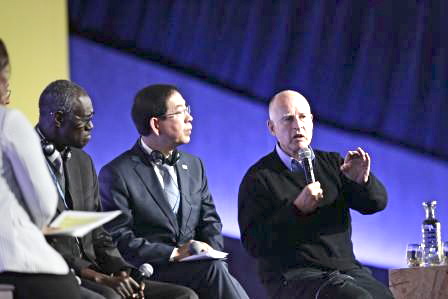
Lawmakers Laud World Climate Pact
‘This is a historic turning point’ — Gov. Brown
Times of San Diego
California lawmakers cheered Saturday’s announcement of a global agreement to reduce greenhouse gas emissions to help prevent serious climate change.
“This is a historic turning point in the quest to combat one of the biggest threats facing humanity,” said Gov. Jerry Brown. “Activists, businesses and sub-national leaders now need to redouble their efforts and push for increasingly aggressive action.”
Brown spent five days at the conference in Paris, during which time he met with UN Secretary-General Ban Ki-moon, China’s Special Envoy on Climate Change Xie Zhenhua and U.S. Energy Secretary Ernest Moniz. Brown and Moniz announced that California will host a clean energy conference in San Francisco next year.
The United Nations’s 21st Conference of the Parties on climate change, or COP21, was held in Le Bourget outside Paris.
“The Paris Agreement that was signed at the end of the United Nations’ COP21 conference is transformational,” said Assembly Speaker Toni Atkins, who represents San Diego. “It will change the world’s approach to fossil fuels, and it establishes an achievable path to reduce greenhouse gas emissions and to respond to the potentially devastating changes caused by climate change.”
Atkins said the new agreement is not the end of actions that must be taken. “In California we know the serious damage climate change can cause to everything from our supply of food and water to the health of our neighborhoods to our national security,” she said.
Many of the governments represented in Paris joined California in signing the Under 2 MOU, an agreement to limit the increase in global average temperature to below 2 degrees Celsius, the warming threshold at which scientists say there will likely be catastrophic climate disruptions. Signatories commit to either reducing greenhouse gas emissions 80 to 95 percent below 1990 levels or limit per capita annual emissions to less than 2 metric tons by 2050.
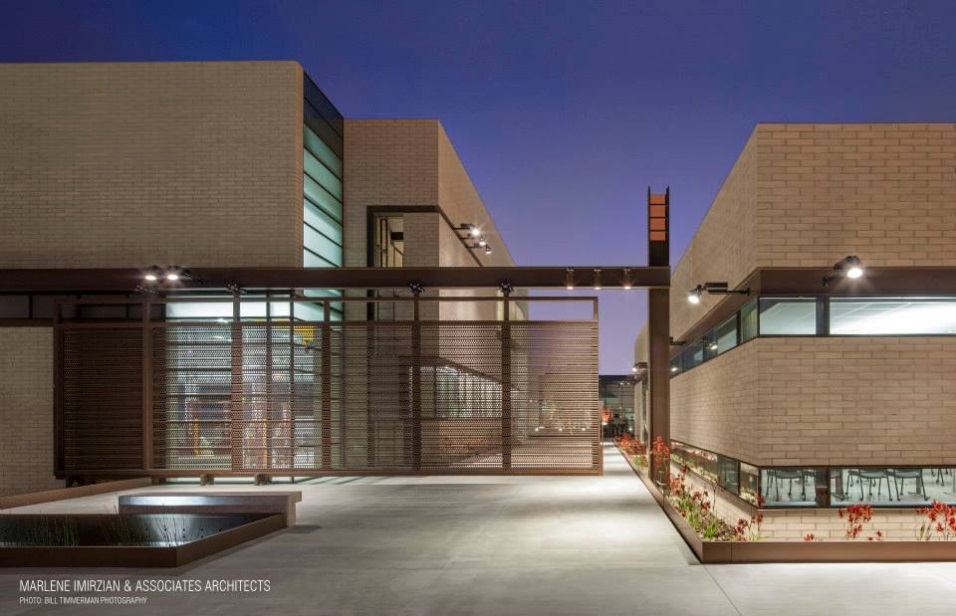
Miramar College Gets Grant to Train
Technicians On Clean Fuels Technology
San Diego Miramar College has secured a $2 million contract to drive a state effort that trains technicians to repair and maintain vehicles using alternative fuels and advanced transportation technologies.
The bulk of the three-year grant going to Miramar College’s Advanced Transportation Technology and Energy Center will be spent working with community colleges statewide in developing curriculum, acquiring equipment and training instructors who are educating students and faculty about clean fuels technology. The remainder will go directly toward educating technicians already in the workforce in becoming better versed in alternative fuels technology, enabling them to master the maintenance of buses and other vehicles that run on compressed natural gas or electric power.
“This contract recognizes the importance of keeping community college technician training on the same path as alternative fuel and advanced transportation technology development, thereby ensuring that new vehicles on the road truly work to achieve the state’s fuel use and emission-reduction goals,” said Greg Newhouse, director of the Advanced Transportation Technology and Energy Center.
The money is being provided by the California Energy Commission through its Alternative and Renewable Fuel and Vehicle Technology Program, which Newhouse coordinates locally.
USD to Offer its First Master’s
Degree in Cyber Security Engineering
University of San Diego’s Shiley-Marcos School of Engineering will offer its first master’s degree in Cyber Security Engineering — an effort to meet the need for more professionals in the field.
“We anticipate high demand for this program that will serve professionals in the military, homeland security, public safety, ecommerce, privacy and technology industries,” said Chell Roberts, dean of the Shiley-Marcos School of Engineering.
“The program also will contribute to San Diego’s efforts to be a leader in the cyber security industry,” added Jason Lemon, dean of USD’s Division of Professional and Continuing Education. “We will be offering additional degrees and certificate programs in the future, including an online master’s in cyber law and policy.”
The program will begin in January 2016 for the 30-unit program that consists of 10 courses. Courses will be offered throughout the year with three starts (each spring, summer and fall). The program is available on-campus during evenings for busy professionals, enabling them to achieve maximum engagement and interaction with faculty and complete the program in less than two years.
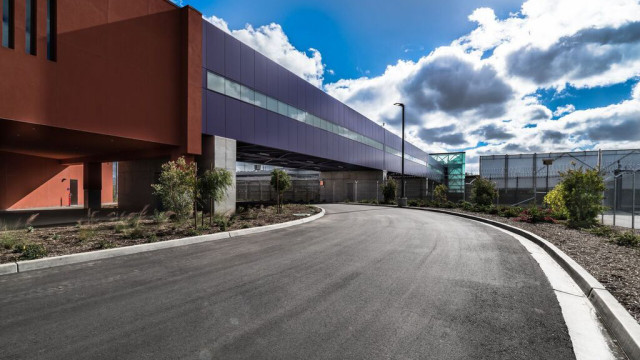
Skybridge From San Diego to Tijuana Airport Opens
City News Service
A cross-border gateway between San Diego and Tijuana’s international airport opened last week.
The enclosed 390-foot pedestrian skybridge spans the U.S./Mexico border and includes a full-service airline terminal on the U.S. side that can be used by ticketed passengers within 24 hours of a departing flight, or for arriving passengers, two hours after landing.
The rest of the privately run Cross Border Xpress terminal, known as CBX, is accessible to members of the public who may be dropping off or picking up passengers. It’s located at 2745 Otay Pacific Drive, between the San Ysidro and Otay Mesa border crossings.
“CBX will transform the border crossing experience for millions of travelers,” said Carlos Laviada, an investor in the project and a frequent flyer.
“We started the planning and approvals for CBX over eight years ago, and it has garnered incredible support on both sides of the border,” Laviada said. “Intercountry travel for leisure and business is a critical economic driver for this entire region.”
UC San Diego Receives $375,000
Grant to Aid in Parkinson’s Research
Aided by a $375,000 grant from the Michael J. Fox Foundation for Parkinson’s Research, UC San Diego School of Medicine researchers hope to improve the prospects of early diagnosis of Parkinson’s disease by identifying a biological signpost in the blood.
Currently, no standard diagnostic test exists for Parkinson’s disease, a chronic and progressive movement disorder affecting nearly 1 million Americans. Instead, physicians use patient symptoms, medical history and a neurological exam to make their diagnosis.
“One of the really unmet needs with Parkinson’s disease is the creation of a simple diagnostic test that can identify the disease early on,” said study leader Paula Desplats, assistant professor in the Department of Neurosciences. “Like other neurodegenerative disturbances, by the time a Parkinson’s patient has outward symptoms, many neurons are lost.”
Earlier diagnosis would enable earlier treatment and hopefully delay neuronal damage and reduce disease symptoms, said Desplats, who is co-principal investigator on the study with Travis Dunckley.
The search for biomarkers — signs that can indicate the presence or progress of a disease — is a major push in Parkinson’s research.
NASSCO Launches First Ship
In Series of ECO Class Tankers

General Dynamics NASSCO on Saturday launched the first ship in a series of ECO Class tankers for the SEA-Vista fleet. The christening and launch ceremony took place at the company’s shipyard in San Diego.
The ship, the Independence, is a 610-foot, 50,000 deadweight-ton, and LNG-conversion-ready product tanker with a 330,000 barrel cargo capacity. The new ECO Class tanker symbolizes the emerging direction of the shipping industry in the U.S. toward cleaner, more fuel-efficient modes of transporting product. Construction on the ship began in November 2014.
As part of the ceremony, the ship’s sponsor, Mrs. Allison Moran, CEO of RaceTrac Petroleum, christened the ship with a traditional champagne bottle break over the ship’s hull. Jayne Rathburn, former CEO/owner of US Joiner, pulled the trigger to release the ship into the San Diego Bay.
The Independence was built for SEA-Vista, a partnership between SEACOR Holdings Inc. and Avista Capital Partners, and will be operated by Seabulk Tankers Inc.
Northrop Grumman Delivers Center
Fuselage for First Japanese F-35
Northrop Grumman Corp. has delivered the center fuselage for Japan’s first F-35 Joint Strike Fighter, an F-35A conventional takeoff and landing aircraft designated AX-1.
“This on-time delivery marks another important step in the F-35 team’s drive to support and help fulfill our allies’ 21st century national security requirements,” said Brian Chappel, vice president and F-35 program manager for Northrop Grumman Aerospace Systems.
The center fuselage is a core structure of the F-35 aircraft. Northrop Grumman designed and produces the center fuselage for all three F-35 variants: the F-35A; the F-35B short takeoff vertical landing variant; and the F-35C carrier variant.
Each F-35 receives an alphanumeric designation based on its variant type (A, B or C), the country for which it flies (e.g., F = U.S., K= United Kingdom, X = Japan), and sequence number of the jet.
The AX-1 center fuselage is one of 42 F-35 center fuselages that Northrop Grumman is producing for Japan. It is the 206th center fuselage that the company has produced at its Palmdale Aircraft Integration Center of Excellence, and the 44th such unit delivered this year.

